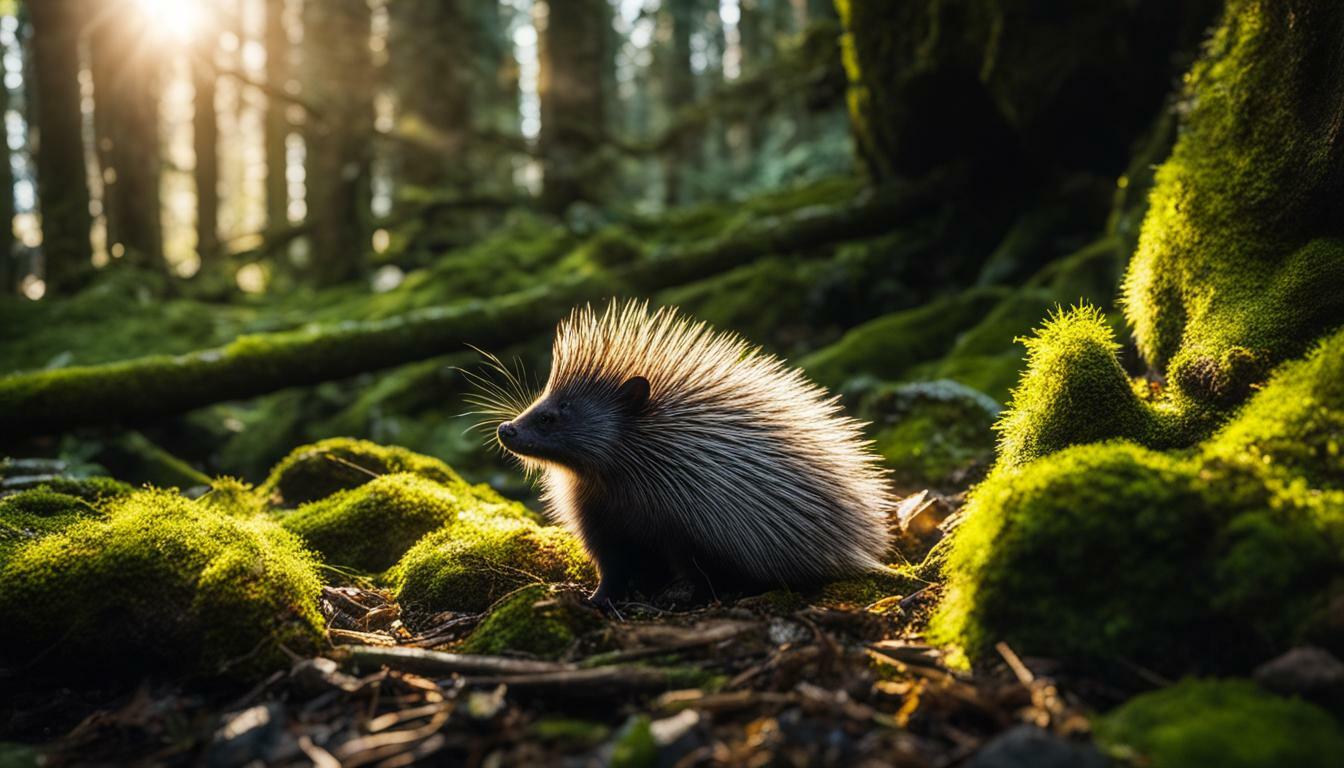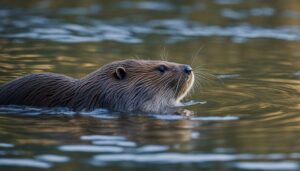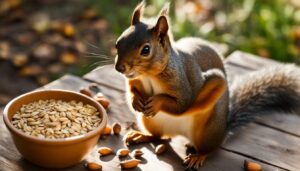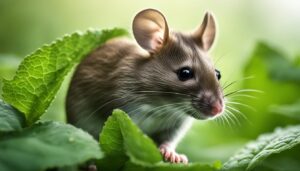Missouri is home to a diverse range of wildlife species, but one question that often arises is whether porcupines can be found in the state. While porcupines are not native to Missouri, there is evidence to suggest that they exist in certain regions, particularly in the northern part of the state where forests are prevalent.
According to the Missouri Department of Conservation, porcupines have been documented in the state on a few occasions. These herbivorous creatures feed on a variety of plants, fruits, and tree bark. They are primarily nocturnal and tend to live solitary lives, except during winter and mating seasons when they may den together or form small groups.
Porcupines can potentially cause damage to houses, sheds, and gardens, often targeting exposed wood or garbage. However, they are not considered a protected species in Missouri, and there is no closed hunting season or bag limit for hunting them.
For those encountering porcupine-related issues, there are several best practices to consider. These include removing potential food sources, securing garbage cans, protecting vulnerable crops and plants, and taking measures to prevent porcupines from entering buildings.
Key Takeaways:
- Porcupines can be found in certain regions of Missouri, particularly in the northern part of the state.
- They are herbivores and feed on a variety of plants, fruits, and tree bark.
- Porcupines are mainly nocturnal and tend to live solitary lives, except during winter and mating seasons when they may den together or form small groups.
- They can potentially cause damage to houses, sheds, and gardens, especially by targeting exposed wood or garbage.
- Porcupines are not considered a protected species in Missouri, and there are no restrictions on hunting them.
Exploring Missouri’s Wildlife
Before addressing the presence of porcupines in Missouri, it is essential to explore the diverse wildlife and animal species that inhabit the state. Missouri is home to a rich variety of wildlife, making it a haven for nature enthusiasts and wildlife enthusiasts alike. From forests to wetlands, the state offers a range of habitats that support an abundance of species.
The forests in Missouri are particularly noteworthy, as they provide a suitable habitat for many animal species. Within these forests, you can find a myriad of mammals, including white-tailed deer, gray foxes, and the elusive black bear. These majestic creatures, along with a vast array of bird species, reptiles, and amphibians, contribute to the remarkable biodiversity that thrives in Missouri’s nature.
Furthermore, the state boasts various wetlands and rivers that serve as important habitats for aquatic species. These waterways support a diverse range of fish, turtles, beavers, and waterfowl. Exploring these wetlands and witnessing the harmony of life they hold is an exceptional experience for any nature lover.
Missouri Wildlife: A Treasured Fauna
Missouri’s wildlife is not limited to its forests and wetlands. The state also showcases an impressive fauna that includes unique species such as the eastern collared lizard and the hellbender salamander. These fascinating creatures, alongside many others, contribute to the ecological balance and natural beauty of Missouri.
| Notable Wildlife in Missouri | Native Species | Iconic Species |
|---|---|---|
| Mammals | White-tailed deer, gray fox, black bear | Eastern cottontail, gray squirrel |
| Birds | Cardinal, blue jay, red-tailed hawk | Turkey, bald eagle, great horned owl |
| Reptiles and Amphibians | Box turtle, copperhead snake, bullfrog | Eastern collared lizard, hellbender salamander |
With such a rich array of wildlife, it comes as no surprise that Missouri is a favored destination for nature enthusiasts, birdwatchers, and photographers. The state’s commitment to preserving its natural heritage ensures that Missouri’s wildlife will continue to thrive and captivate for generations to come.
Understanding Porcupines’ Habitat
To determine the presence of porcupines in Missouri, it is crucial to understand their preferred habitat and the specific regions where they have been sighted. Porcupines are typically found in areas of the state with forests, as they rely on trees for both food and shelter. The Missouri Department of Conservation has documented sightings of porcupines in a few select regions, predominantly in the northern parts of the state.
Porcupines are herbivores that consume a variety of plants, fruits, and tree bark. They have a particular affinity for the inner bark of trees, which they gnaw on to obtain nutrients. Their diet and feeding habits make forests and wooded areas their ideal habitat.
When it comes to their behavior, porcupines are mainly nocturnal creatures. They are most active during the night, venturing out of their dens to forage for food. Porcupines generally lead solitary lives, but during the winter and mating seasons, they may den together or group up.
| Characteristics | Details |
|---|---|
| Diet | Plants, fruits, tree bark |
| Activity | Mainly nocturnal |
| Social Behavior | Solitary, except during winter and mating seasons |
Porcupines can cause damage to houses, sheds, and gardens if they come into close proximity with human-developed areas. They may feed on exposed wood or garbage, leading to potential issues. It is important to be aware of their presence and take appropriate measures to manage any porcupine-related problems.
Please note that porcupines are not considered a protected species in Missouri. Therefore, there is no closed hunting season or bag limit for hunting them. However, it is always advisable to consult local hunting regulations and obtain any necessary permits or licenses before engaging in any hunting activities.
Porcupines’ Diet and Behavior
Porcupines’ diet and behavior play a significant role in understanding their presence and impact in Missouri’s wildlife. These fascinating creatures are herbivores, consuming a variety of plants, fruits, and tree bark. With their sharp quills as protection, porcupines can confidently feed on exposed wood or garbage, which can result in damage to houses, sheds, and gardens.
Mainly nocturnal, porcupines are known for their solitary lifestyle. However, during the winter and mating seasons, they may den together or form groups. It is not uncommon to find these solitary creatures seeking companionship during these particular times.
To effectively manage porcupine-related issues in Missouri, it is crucial to employ best practices. Removing food sources such as fallen fruits and vegetables, securing garbage cans, and taking measures to protect vulnerable crops and plants from their feeding activities can help prevent damage. Additionally, sealing off entry points to buildings and other structures can mitigate the risk of porcupine intrusion.
Porcupines’ Impact on Missouri Wildlife
Porcupines, although not native to Missouri, have been documented in several areas of the state, particularly those with forests. While porcupines are not considered a protected species in Missouri, it is essential to manage their impact on the local ecosystem. Their feeding habits, especially on vulnerable plant species, can have long-term consequences.
| Best Practices for Porcupine Management |
|---|
| Remove fallen fruits and vegetables to eliminate potential food sources for porcupines. |
| Secure garbage cans to prevent porcupines from accessing them. |
| Protect vulnerable crops and plants from porcupine feeding activities. |
| Seal off entry points to buildings and structures to prevent porcupine intrusion. |
By implementing these best practices, individuals and communities can better coexist with porcupines while minimizing any negative impacts on Missouri’s wildlife and nature.
Potential Impact and Habitats
Porcupines’ presence in Missouri’s wildlife habitats can have both positive and negative impacts, and understanding these factors is crucial for conservation efforts. While porcupines play a significant role in the ecosystem, their feeding habits and behaviors can sometimes result in conflicts with humans.
One potential positive impact of porcupines in Missouri is their role in shaping forest ecosystems. Porcupines primarily feed on tree bark, which helps to maintain healthy forest dynamics by removing dead or diseased trees, stimulating new growth, and creating openings for other plant species. Their foraging behavior can also contribute to the dispersal of seeds, aiding in the regeneration of plant communities.
However, porcupines can also cause damage to human structures and landscapes. They may target houses, sheds, and gardens, leading to destruction of wooden structures and potential economic losses. In addition, porcupines can feed on exposed wood and garbage, which can attract other wildlife and pose sanitation concerns.
- To mitigate the potential negative impact, it is important to implement best practices for porcupine management in Missouri.
- Remove potential food sources, such as fallen fruits and vegetables, to discourage porcupines from frequenting human-inhabited areas.
- Secure garbage cans with tightly fitting lids to prevent access.
- Protect vulnerable crops and plants by utilizing fencing or other physical barriers.
- Seal off entry points to buildings to prevent porcupines from seeking shelter indoors.
By adopting these management strategies, individuals and communities can coexist with porcupines while reducing the potential for conflicts. It is important to remember that while porcupines may pose challenges, they are an integral part of Missouri’s wildlife and should be approached with respect and conservation in mind.
| Positive Impacts | Negative Impacts |
|---|---|
| Contributes to forest ecosystem health | Potential damage to houses, sheds, and gardens |
| Aids in seed dispersal and plant regeneration | Feeding on exposed wood and garbage can attract other wildlife |
Legal Status in Missouri
Understanding the legal status of porcupines in Missouri is essential for managing their presence in the state’s wildlife. While not native to Missouri, there is evidence that porcupines have been documented in the state a few times, primarily in regions with forests. The Missouri Department of Conservation recognizes their occasional presence and provides guidelines for dealing with porcupines.
Porcupines are not considered a protected species in Missouri, and there is no closed season or bag limit for hunting them. This means that individuals who encounter porcupines on their property or in their vicinity have the right to take necessary measures to manage their presence. However, it is important to approach porcupine management responsibly and ethically, considering the long-term impact on wildlife and the environment.
To effectively manage porcupines, it is recommended to follow certain best practices. These include removing potential food sources such as fallen fruits or exposed garbage, securing garbage cans with tight lids, protecting vulnerable crops and plants from porcupine damage, and preventing their entry into buildings by sealing any openings or gaps. By implementing these practices, individuals can minimize conflicts with porcupines and protect their properties while ensuring the well-being of these fascinating creatures.
| Legal Status | Hunting Season | Bag Limit |
|---|---|---|
| Not Protected | No Closed Season | No Bag Limit |
Best Practices for Porcupine Management
Implementing best practices for porcupine management can help mitigate potential issues and create harmony between wildlife and human habitats in Missouri. While porcupines may not be native to the state, there is evidence that they exist in certain regions, particularly in the northern parts, where forests provide suitable habitat.
To minimize conflicts with porcupines, it is important to take preventive measures. Here are some recommended practices:
- Remove food sources: Porcupines are herbivores and may be attracted to gardens, crops, and exposed wood. Clearing away fallen fruit, vegetables, and other potential food sources can discourage them from frequenting human-inhabited areas.
- Secure garbage cans: Porcupines may be attracted to garbage, so it is essential to use secure, animal-proof containers to prevent them from accessing waste material.
- Protect vulnerable crops and plants: Installing fencing or barriers around gardens and other vulnerable areas can help prevent porcupines from causing damage to plants and crops.
- Prevent entry into buildings: Seal openings and cracks in buildings to prevent porcupines from entering and causing damage to structures.
By following these best practices, individuals can minimize the potential impact of porcupines on their properties and maintain a healthy balance between wildlife and human habitats in Missouri.
| Best Practices for Porcupine Management |
|---|
| Remove food sources |
| Secure garbage cans |
| Protect vulnerable crops and plants |
| Prevent entry into buildings |
Porcupines – A Fascinating Species
Porcupines are fascinating creatures that contribute to the biodiversity and ecological balance of Missouri’s fauna. While not native to the state, there is evidence of their presence in certain regions of northern Missouri, according to the Missouri Department of Conservation. Typically found in areas with forests, porcupines have been documented in the state a few times.
Porcupines are herbivores, feeding on a variety of plants, fruits, and tree bark. Their diet plays a crucial role in the ecosystem, contributing to the dispersal of seeds and shaping the vegetation composition in their habitat. Although they are mainly nocturnal and live a solitary life, during winter and mating seasons, porcupines may den together or form small groups.
As they forage for food, porcupines may cause damage to houses, sheds, and gardens. They have a tendency to feed on exposed wood or garbage, which can pose problems for humans. Despite their impact on human habitats, porcupines are not considered a protected species in Missouri. There is no closed hunting season or bag limit for hunting them.
| Best Practices for Porcupine Management |
|---|
| 1. Remove potential food sources, such as fallen fruits, vegetables, or exposed wood. |
| 2. Secure garbage cans and compost bins to prevent porcupines from accessing them. |
| 3. Protect vulnerable crops and plants by using fencing or deterrents. |
| 4. Seal any entry points to buildings, such as gaps in walls or under decks, to prevent porcupines from entering. |
By implementing these best practices, you can effectively manage porcupine-related issues and reduce their impact on your surroundings. Remember, although porcupines may be intriguing to observe, it is essential to ensure a harmonious coexistence with these unique creatures while safeguarding your property.
Conservation Efforts and Future Outlook
Conservation plays a vital role in ensuring the long-term presence and well-being of porcupines in Missouri’s wildlife. While porcupines are not native to the state, there is evidence to suggest their presence in certain regions, particularly in northern Missouri where forests provide suitable habitats.
The Missouri Department of Conservation has documented porcupine sightings in the state, albeit sporadically. As these unique creatures contribute to the biodiversity of Missouri’s wildlife, it is important to protect their habitats and ensure their sustainable future in the state.
In terms of their impact on human habitats, porcupines can cause damage to houses, sheds, and gardens. They have a penchant for feeding on exposed wood and garbage, posing potential threats to structures and vulnerable plant species. Therefore, proactive management practices can help mitigate their negative impact.
Best Practices for Porcupine Management
- Remove food sources: Ensure that garbage cans are securely closed and that food remains are not easily accessible, reducing the chance of attracting porcupines to residential areas.
- Protect vulnerable crops and plants: Implement measures such as fences or netting to safeguard gardens and agricultural fields from porcupine feeding behavior.
- Prevent entry into buildings: Seal gaps or openings in structures that could serve as entry points for porcupines, keeping them from causing damage to houses or sheds.
By following these best practices, individuals, communities, and wildlife management authorities can contribute to maintaining a healthy balance between porcupines and human habitats in Missouri. Continued conservation efforts and awareness about these unique creatures will ensure their presence and well-being for generations to come.
| Porcupine Management | Actions |
|---|---|
| Remove food sources | Securely close garbage cans, dispose of food waste properly |
| Protect vulnerable crops and plants | Install fences or netting to prevent porcupine feeding |
| Prevent entry into buildings | Seal gaps and openings in structures |
Conclusion
In conclusion, while porcupines are not native to Missouri, there is evidence of their existence in certain areas, primarily in the northern parts of the state. The Missouri Department of Conservation has documented porcupines in Missouri a few times, mainly in regions with forests. These herbivorous creatures have a diverse diet that includes plants, fruits, and tree bark.
Porcupines are mainly nocturnal and prefer a solitary lifestyle, although they may den or group together during the winter and mating seasons. Their presence can cause damage to houses, sheds, and gardens, particularly if exposed wood or garbage is available for them to feed on.
It is important to note that porcupines are not considered a protected species in Missouri, and there are no restrictions on hunting them. However, for effective porcupine management, it is recommended to implement best practices such as removing food sources, securing garbage cans, protecting vulnerable crops and plants, and taking measures to prevent their entry into buildings.
While porcupines may pose challenges for some residents of Missouri, they also play a vital role in the ecosystem. Their unique features, defensive mechanisms, and ecological importance make them a fascinating species worth understanding and conserving for the future.
FAQ
Are porcupines native to Missouri?
No, porcupines are not native to Missouri, but they have been documented in the state a few times.
Where are porcupines typically found in Missouri?
Porcupines are typically found in areas of Missouri with forests.
What do porcupines eat?
Porcupines are herbivores and eat a variety of plants, fruits, and tree bark.
Are porcupines nocturnal?
Yes, porcupines are mainly nocturnal and are most active during the night.
Do porcupines live in groups?
Porcupines live a solitary life, except during winter and mating seasons when they may den together or group together.
Can porcupines cause damage to houses and gardens?
Yes, porcupines can cause damage to houses, sheds, and gardens. They may feed on exposed wood or garbage.
Are porcupines protected in Missouri?
No, porcupines are not considered a protected species in Missouri.
Are there any restrictions on hunting porcupines in Missouri?
There is no closed season or bag limit for hunting porcupines in Missouri.
What are the best practices for managing porcupine issues?
Best practices for managing porcupine issues include removing food sources, securing garbage cans, protecting vulnerable crops and plants, and preventing their entry into buildings.




